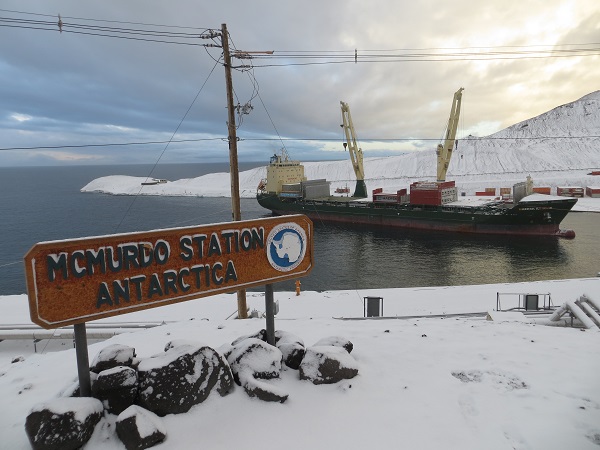Lee and I took the Otter to Margaret AWS today, Monday 3 February. This station was installed in 2008 and had never been visited since. We knew that it was due to be raised, for two reasons:
One, with stations that we’ve installed on snow, it is almost always the case that there is snow accumulation, by precipitation and/or blow and drifting. The amount of accumulation depends on the location; some stations can get up to a few feet each year, and some don’t get any. If we know approximately how much snow an area gets a year, we can estimate how often we need to visit a station to raise it given the height of the instrumentation.
Two, the ADG (Acoustic Depth Gauge) instrument we have on Margaret recorded a height of about a half meter (1.5 feet) above the surface a few months ago. Many of our stations have this instrument, and it is a good way of knowing exactly how close the instruments are to getting buried. The ADG sends a pulse of sound waves towards the snow surface and measures the time it takes for that pulse to bounce back and reach the sensor. The longer the pulse takes, the higher the ADG is off the ground.
Knowing that we have to raise the station is half the battle. The tricky part is actually getting there (especially in Margaret’s case). It is by Roosevelt Island, on the Ross Ice Shelf about 500 km (310 miles) due east of McMurdo (a 2.5 hour flight). In this region, low cloud cover occurs often and in abundance (my previous blog post touched on this, when we visited the WISSARD fuel cache). I don’t know how many times we’ve been scheduled to go to Margaret this season and got canceled due to weather, flying somewhere else instead. We were pleasantly surprised to hear that Margaret was a go today. We flew across the shelf (a pretty boring flight, scenery-wise) and arrived at the station to be greeted by clear skies overhead.
The ADG is the instrument on the lowest “arm” that extends to the left at the bottom of the station. It was indeed low, as we expected, so we got to work right away on preparing everything to be raised.
We weren’t sure whether we should try to install a 7-foot or a 10-foot tower section to raise the station, so we brought both and made a game-time decision. We determined that the tower was tall enough to only warrant a 7-foot tower section. We felt that the 10-footer would have been too tall and that station may not have remained stable.
Unfortunately, the 7-foot tower section wouldn’t fit on top of Margaret. One, or both, of the tower sections was slightly skewed such that we could only fit 2 of the 3 poles of the tower section on at one time. After a few minutes struggling with it, Lee and I decided to give up on that and raise the instrumentation on Margaret’s current tower section. We probably won’t be able to wait 5 years until the next visit, but the instruments should be high enough for a few years’ time.
Things didn’t go exactly as planned, but we were happy to get the instruments raised and have a successful trip to Margaret. We don’t take any flights to that region for granted!
An update on life in McMurdo:
The population has increased a bit in the past week, and ships have been in and out of the port. Now, the vessel is in town. For the next week, people in town are working tirelessly to unload the cargo from the vessel to supply McMurdo with food and other vitals for the next year. Once that’s all unloaded, cargo from McMurdo that needs to be shipped back to the US gets loaded on. This includes everything from science equipment to food waste. As you may imagine, it is a long operation. The weather is also starting to cool down here. Highs have mostly been in the low 20’s, and winds are starting to increase. This past Saturday night, it even snowed. It was fairly heavy for a bit too. It’s actually starting to feel like Antarctica again!
Cheers!
Dave







